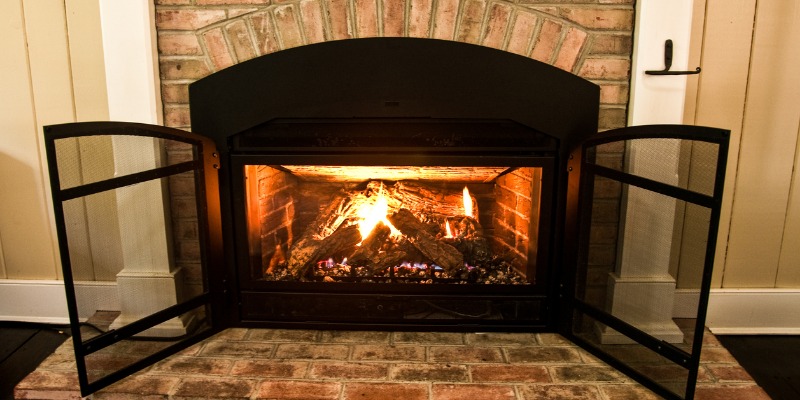There are a lot of questions you may ask yourself when thinking about a fireplace or furnace for your home. How much energy will my electric fireplace use? What is the cost of running a gas fireplace vs furnace? Should you rely on your fireplace to heat a part of your home?
Let’s look at a comparison of the four systems: gas fireplaces, electric fireplaces, wood fireplaces, and furnaces. We’ll compare features such as heat efficiency and energy consumption.
Gas Fireplaces

- Convenient: Enjoy real flames without the hassles of solid fuel.
- The air stays clean. No ash or creosote is produced with a gas-burning fire.
- Great for zone heating. Zone heating refers to heating your home in zones by lowering your thermostat in the rest of the house and turning up the gas fireplace in one room.
- Aesthetics: Looks traditional or modern, depending on the style you choose.
- Easy to install: Can be vented through an existing chimney.
- Requires little maintenance. A check-up once a year is all you’ll need.
- Energy-efficient: Burn with a 65% to 99% efficiency rating.
Everything has a downside. With gas fireplaces, there are some costs involved. You won’t save money heating your whole house with a gas fireplace over a furnace. However, it will cost less than an electric fireplace.
Electric Fireplaces
- Save space: Come in elegant designs that don’t limit the space in a room.
- Durable: They don’t use wood or gas and won’t corrode, so your fireplace will stay fresh looking.
- Easy to move: They are designed to be portable, so you can move them from one room to another if you’re redesigning a space, or from one home to another.
- Simple to use: Easy to control, usually with a remote.
- Easy to install: Doesn’t require a chimney or gas lines.
- Energy-efficient: Does not lose heat through a chimney. Plus, most achieve a 99% efficiency rating.
The downside of electric fireplaces is that they use electricity. If you live in an area that suffers from power outages, then this source of heat won’t help you in a storm or when the power is out.
Plus, electric fireplaces draw maximum power when on. Therefore, ensure your home has enough available voltage to power the fireplace safely.
Wood Fireplaces

- Environmentally friendly: Wood-burning appliances leave less carbon footprint.
- Highly efficient. Can distribute heat through existing ductwork in your home.
- Affordable: Low energy costs.
- Reliable: Provides warmth during blackouts.
- Energy independence: Take control of your fuel supply with a wood fireplace.
- Ambiance: It’s hard to match the crackle and smell of a real burning fireplace.
Wood fireplaces have their drawbacks too! The main downside is that there’s a lot of maintenance and upkeep involved. You’ll have to make sure you have a supply of wood to feed the fire, somewhere to keep your stack of firewood, and you will have to buy or chop the wood for kindling (smaller wood to start fires).
You will need to clean the fireplace and chimney often to ensure it’s running safely and efficiently.
Furnaces
In Canada, no matter how many fireplaces you have, you’ll still need a furnace. So, you may wonder about how they stack up. Here are their main benefits:
- Reliable: Worry-free heat in even the coldest months of winter.
- Low-maintenance: Requires less maintenance than the alternatives we’ve discussed, due to only being used during the cool months. Maintenance once or twice a year should be enough to keep your system in good working order.
- Affordable: Electric furnaces are inexpensive to install and have a life span of about 20-30 years. In most cases, natural gas is less expensive than electricity. You can save a significant amount on winter heating costs with a gas furnace.
- Energy-efficient: Gas furnaces operate at up to 98% efficiency.
The downside of your furnace will depend on its type. Electric furnaces are more expensive to run than gas, but some gas furnaces have a shorter life span.
Gas heating systems require ventilation equipment to dispel toxic gases such as CO2, and leaks can happen if the unit isn’t maintained properly, which is why you’ll need to ensure your furnace is running safely and efficiently with regular checks.
Whichever model is best for you, get in touch with a local Ontario ClimateCare location for all of your fireplace and furnace needs, or to get answers to any questions you have about how much energy your electric fireplace will use.




